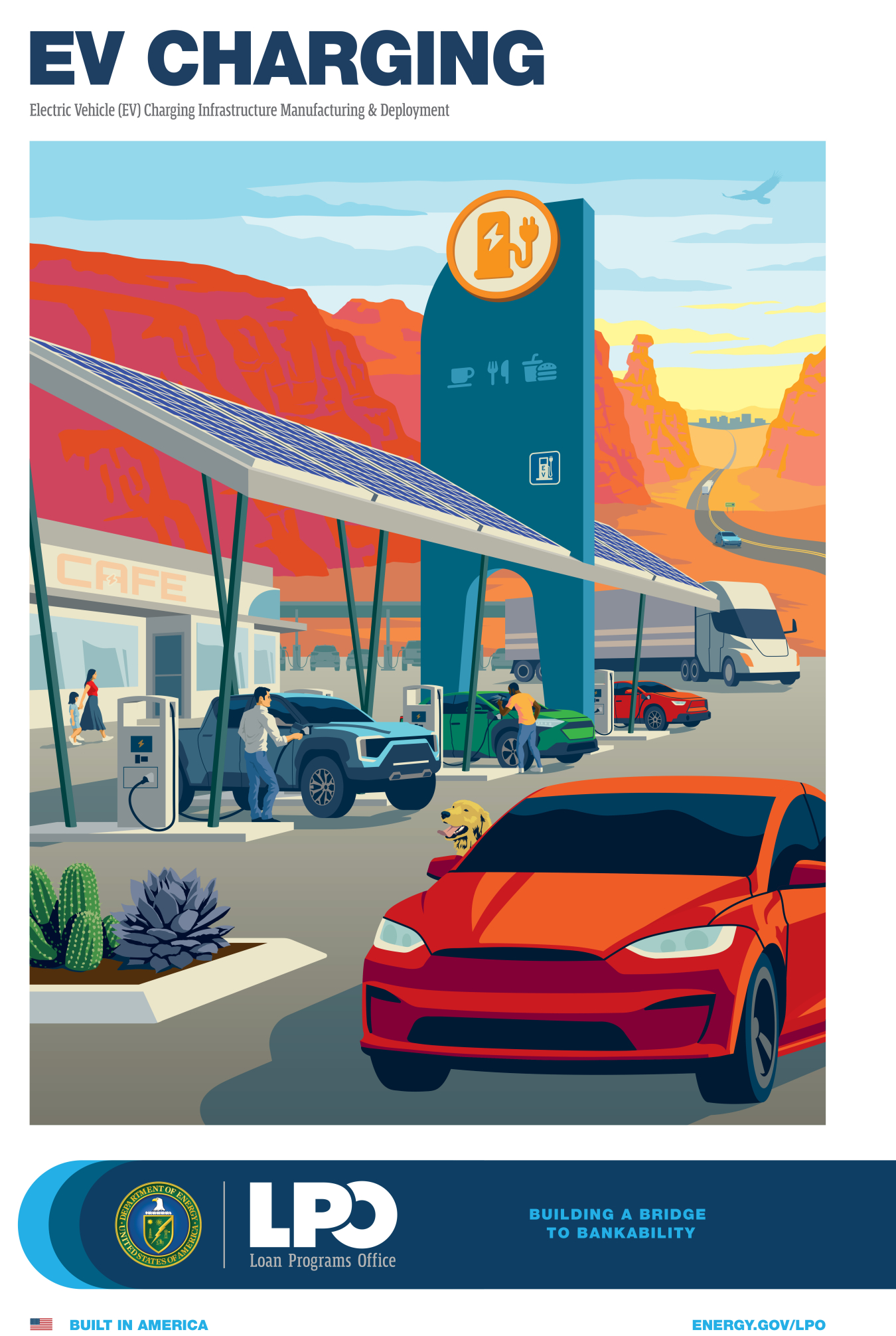This Tech Talk highlights how LPO is working to support deployment of electric vehicle and fleet charging solutions in the United States to facilitate the transition to a clean energy economy.
December 12, 2023
Download LPO's EV Charging poster.
In support of President Biden’s ambitious goal for electric vehicles (EVs) to make up half of all automotive sales by 2030, the Department of Energy’s (DOE) Loan Programs Office (LPO) is helping to ensure that the nation’s charging infrastructure is prepared to meet increased EV demand and supercharge domestic manufacturing. Reducing transportation sector emissions is a critical component of the Biden-Harris Administration's efforts to combat the climate crisis and reach a net-zero economy by 2050.
LPO’s Advanced Technology Vehicle Manufacturing (ATVM) Loan Program provides loans to support manufacturing facilities for eligible vehicles and qualifying components. The ATVM Loan Program has played a key role in helping the American auto industry propel the resurgence of manufacturing in the United States. Additionally, LPO’s Title 17 Clean Energy Financing Program can provide loans to support the deployment of EV charging infrastructure, including associated hardware and software.
In addition to LPO, the Biden-Harris Administration has laid out a comprehensive, all-of-government approach to building out EV charging infrastructure around the country. The President’s Bipartisan Infrastructure Law (BIL), through programs administered by the Joint Office of Energy and Transportation, is investing $7.5 billion to build a national network of 500,000 EV chargers so that charging EVs is predictable, reliable, and accessible. Additionally, through the DOE’s Manufacturing and Energy Supply Chains Office, more than $7 billion is available to ensure domestic manufacturers have the critical minerals and other components necessary to make batteries. More than $10 billion is also available for clean transit and school buses through the Environmental Protection Agency. President Biden’s Inflation Reduction Act (IRA) also provides incentives for buyers of new and used EVs, credits to help manufacturers retool existing facilities and build new manufacturing in the United States, and grants to deploy zero-emission heavy-duty vehicles.
WHY EV CHARGING?
Decarbonizing the U.S. transportation sector, the largest contributor of greenhouse gas (GHG) emissions, will require widescale adoption of EVs, primarily light-duty passenger vehicles and medium- and heavy-duty trucks. According to projections, the United States will have 30 to 42 million light-duty EVs on the road by 2030. Meeting the needs of these drivers will require a robust network of chargers spanning homes, multi-unit dwellings, workplaces, and public locations such as grocery stores and highway rest stops, and commercial and industrial depots. One barrier to greater EV adoption is “range anxiety,” or the worry that an EV driver won’t be able to find a charging station when needed. Expanding the EV charging network can alleviate this concern for potential EV adopters, making EVs a more attractive vehicle option.
Producing and deploying chargers of different speeds is also critical to meet differing charging needs. Level 1 charging, for example, requires the most time to recharge an EV, but can easily fulfill average daily driving needs and is the least expensive and easiest to install at home. Level 2 chargers are faster but more expensive. DC Fast chargers, the quickest yet most expensive, are ideal for public charging stations where drivers are often in a hurry. Public fast chargers will also be essential for people without access to home charging.
Fleet charging, which refers to charging multiple vehicles in the same space, is useful for commercial vehicle fleets. Cargo vans for deliveries, car rentals, pickup trucks for construction, semi-trucks, and city and school buses could utilize fleet charging. Electrifying heavy-duty vehicles like trucks that are involved in transporting goods to and from ports will substantially reduce freight-related emissions and local air pollution that often fall disproportionately on disadvantaged communities (DACs). Battery-as-a-service (BaaS), which allows customers to lease batteries separately for their vehicle, could help defray some of the upfront costs of purchasing a vehicle such as an electric truck.
One key priority in the build-out of EV charging is maximizing compatibility and interoperability between different charger types. The current network of over 150,000 public chargers operates with different plug types, payment options, networks, and hardware configurations. Standardizing charging operations across vehicle manufacturers can help make public charging more convenient for drivers.
In addition to benefitting EV drivers themselves, EVs can also improve grid resilience and electricity affordability when connected to a Virtual Power Plant (VPP). VPPs can provide the grid additional capacity during peak demand, offering a less expensive and lower-emissions alternative to operating a natural gas peaker plant. Utilizing EVs as part of VPPs can lower electricity prices for everyone and reduce GHG emissions and pollution from peaker plants, which are disproportionately located near DACs.
HOW LPO CAN HELP
LPO can finance projects across the EV charging supply chain, including but not limited to:
- Components: Construction of facilities that manufacture EV charging components, such as cables, plugs, power electronics, dispenser cabinets, and more.
- Smart EV Charging Infrastructure: Projects that manufacture or deploy smart EV charging infrastructure including VPPs and V2G.
- Shipping and Transportation: Deployment of clean energy infrastructure to electrify ports (e.g., charging infrastructure for drayage, workboats, cranes), truck stops, freight depots, airports, and more.
LPO AUTHORITIES THAT CAN SUPPORT EV CHARGING PROJECTS
LPO can finance EV charging manufacturing and/or deployment through several avenues. To view up-to-date remaining loan authority amounts, view the Monthly Application Activity Report (MAAR), where these amounts are updated on a monthly basis. Financing options for EV charging projects include:
- Advanced Technology Vehicles Manufacturing Program: Financing for manufacturing facilities for advanced technology vehicles and qualifying components. Select EV charging hardware and components are potentially eligible for financing.
- Title 17 Clean Energy Financing Program – Innovative Energy and Innovative Supply Chain (Section 1703): Financing for projects, including EV charging infrastructure, that employ innovative manufacturing processes or manufacture innovative technologies at commercial scale. The loan can cover equipment procurement and construction/installation.
- Title 17 Clean Energy Financing Program – State Energy Financing Institution (SEFI) – Supported Projects (Section 1703): Financing for projects, including EV charging infrastructure, that support deployment of qualifying clean energy technology and receive meaningful financial support or credit enhancements from an entity within a state agency or financing authority.
- Tribal Energy Financing Program: Financing available to federally recognized tribes and qualified tribal energy development organizations for energy development projects, including EV charging projects. These projects are not required to use innovative technologies.
NEXT STEPS
To learn more about how LPO could support your EV charging manufacturing or deployment project, please request a no-cost pre-application consultation. During the consultation, LPO will work with you to determine whether the project is eligible for financing.
To learn more about how DOE supports EV charging-related projects, visit the Joint Office of Energy and Transportation.
Contributors: Anthony Bolanos, Chelsea Sexton, Wayne Killen, and the Vehicle Technologies Office.
Michael Reed

Michael Reed is the Director of the Technical and Environmental Division (TED) for the Department of Energy’s Loan Programs Office (LPO). In this role, he provides technical management and performance monitoring of LPO’s $30 billion portfolio of clean energy projects. This portfolio includes projects in renewable energy and energy efficiency, advanced technology vehicle manufacturing, advanced fossil, nuclear, and related transmission infrastructure. Mr. Reed also oversees the technology evaluations of new applications submitted under open LPO solicitations.
Mr. Reed has over 30 years of diverse technical and leadership experience, serving as a senior executive and chief engineer in both the private and government sectors. Prior to joining LPO, Mr. Reed was the Chief Engineer of the U.S. Department of Energy’s Water Power Program, and the Vice President of Engineering for numerous defense and energy consulting companies. He has served in the U.S. Navy and the Naval Sea Systems Command, working on advanced power and propulsion systems.
Mr. Reed earned his BS in Engineering from the US Merchant Marine Academy, and an MS in Environmental Science and Policy from The Johns Hopkins University.

